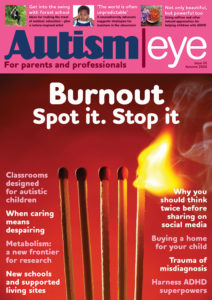 Ifigeneia Mourelatou, Autism Practitioner & ESDM Specialist at Re:Cognition Health, shares her insight.
Ifigeneia Mourelatou, Autism Practitioner & ESDM Specialist at Re:Cognition Health, shares her insight.
In recent years it has become more and more mainstream that parents and sometimes extended family members, such as grandparents or caregivers, including nannies or childminders, are highly involved in their little one’s autism intervention.
This has not always been the case. Previous mainstream guidance from a few years ago advised that a child with autism required an extensive amount of ‘treatment’ hours per week with therapists (e.g. 40 hours of intensive behavioural interventions).
This frequently resulted in young children being away from their families for too many hours at a very sensitive age. Even worse, children were becoming unhappy or lacking confidence due to the high intensification of their week.
However, recently published data shows that the evidence base regarding intervention intensity for young children with autism has changed.
According to this research, there is no conclusive evidence to support recommendations for intensive interventions for all young children with autism.
Instead, the recommendations on intervention intensity should always consider the individual needs, priorities, and preferences of each family (Sandbank, Bottema-Beutel, & Woynaroski, 2021).
More family-centred
There has also been a shift from medicalised models that assume the specialist is the expert and the one who makes the decisions towards a more family-centred model, where parents and the parent coach pool their expertise and collaborate.
The rationale behind this is that the professional has expertise in autism and intervention, but the parent is the one who knows their child better than anyone else.
Through Parent Coaching, parents and caregivers can improve the ways they interact and play with their child in an enriched and responsive way and thus they become the child’s ‘therapist’, under the ongoing supervision and support of the parent coach.
Parents can be highly effective
Young children spend most of their waking hours (approximately 75 hours per week) with caregivers in everyday activities and contexts. Parents spend more time with their little ones than any therapist could possibly spend; hence, they can be greatly effective in implementing the intervention (Dawson & Bernier, 2013).
Changing those daily interactions by responding more sensitively to the learning needs of young autistic children can provide more opportunities for practice and learning than any external provider can. Even when external providers work with the child, there is still a need for active parental involvement for emotional and practical reasons.
Emotional needs
The degree of parental involvement may vary enormously across interventions, with parents acquiring the role of leading therapist, acting as co-therapists or demonstrating minimum participation during the intervention (Thompson, 2011).
It is crucial to bear in mind that children at such young and sensitive ages have particular developmental and emotional needs, which may call for their parents to actively take part in the process.
There may be practical obstacles to the above; parents may find it difficult to accept the diagnosis and consequently may not be able to cope with the emotional burden of being the primary therapist to their child (Remington et al., 2007).
However, a high level of parental involvement at all stages would most probably benefit the child, boost the parents’ confidence, and ensure the intervention is effective.
Level of parental participation in intervention
The nature of each intervention determines the level of parental participation: when it can apply in naturalistic settings (e.g. the home environment) and include daily routines, it can be more easily carried out by the parents.
Last but not least, it is of great importance that parent-mediated interventions are frequently monitored by early intervention specialists (Oono, Honey & McConachie, 2013).
But where can these models be found? Luckily, in 2022 you do not have to travel far to access parent coaches; they are available around the world, offering virtual sessions and guiding parents, who then apply the intervention principles with their child at home.
Families, therefore, can be linked with certified providers from any other part of the world. Some evidence-based parent coaching models include Hanen’s ‘More than Words’, Early Start Denver Model (ESDM), Paediatric Autism Communication Therapy (PACT), and Joint Attention Symbolic Play Engagement & Regulation (JASPER), to name a few.
References
Dawson G. & Bernier R. (2013): ‘A quarter century of progress on the early detection and treatment of autism spectrum disorder’, Dev Psychopathology, 25(4 Pt 2), 1455-72. doi: 10.1017/S0954579413000710.
Oono I. P., Honey E. J. & McConachie H. (2013): ‘Parent-mediated early intervention for young children with autism spectrum disorders (ASD)’, Cochrane Database Syst Rev, 33, 4:CD009774. doi: 10.1002/14651858.CD009774.pub2
Remington B., Hastings R. P., Kovshoff H., degli Espinosa, F., Jahr, E., Brown, T. et al. (2007): ‘Early intensive behavioral intervention: outcomes for children with autism and their parents after two years’, Am J Ment Retard, 112(6), 418–438.
Rogers, S. J., Vismara, L. A., & Dawson, G. (2021): Coaching parents of young children with autism: Promoting connection, communication, and learning, The Guilford Press
Sandbank, M., Bottema-Beutel, K., & Woynaroski, T. (2021): ‘Intervention Recommendations for Children With Autism in Light of a Changing Evidence Base,’ JAMA pediatrics, 175(4), 341–342. https://doi.org/10.1001/jamapediatrics.2020.4730
Thompson, T. (2011): Early Intervention Dimensions. In Individualized Autism Intervention for young children: Blending Discrete Trial and Naturalistic Strategies, Baltimore: Paul H. Brookes Publishing Co.
https://helpisinyourhands.org/course
https://www.jaspertraining.org/




















